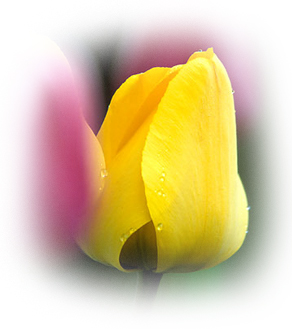Tulips
|
|
Tulipa sppLiliaceae
Cultivation came about in the 13th century. The name tulip comes from the Turkish name "Tullbend" which describes the turban shaped flower. During the Ottoman Empire people developed a great passion for the tulip even to the point that festivals were organized during the blooming period. |
|
|
In 1593 the Austrian Ambassador Ghislain de Busbecq served in Constantinople in Suliman the Magnificent's Court. He was so enchanted with the tulip that he sent bulbs to the botanist Carolus Clusius. Then he started to cultivate them in Holland where they acclimatized well. In the 1630s the bulbs where highly expensive (about 40 times the average worker's salary or the price of a small house) some where stolen and resold on the black market. Tulipmania was in full swing. The government intervened to lower and stabilize the price.
In Victorian times the intended message varied with the colour
During wartime the Dutch people dug up the bulbs and cooked them to survive. Here in Ottawa the Royal Dutch family were given excile and Princess Margriet was born in the Civic Hospital witch was declared Dutch soil. After the end of the war Princess Juliana presented Ottawa with 100,000 tulips annually in appreciation of their safety. |
|
|
In the Garden
Full sun to light shade, prefers well-drained soil. Plant in September/October in a well prepared bed that was amended with compost and bloodmeal. Plant pointed end up they need six weeks before frost for the root system to establish. From a design point of view toss and plant as they land 8" to 10" in depth depending on the bulb size; the larger the bulb the deeper you plant. For an impressive show plant in groups on ten to twelve bulbs, add bloadmeal or bonemeal, cover with soil and mulch. When handling the bulb rodents can pick up the scent from the hand to bulb transfer. Plant the bulbs with gloves on, remove the gloves and put on a fresh pair to cover the scent. In the springtime after flowering, remove the spent flowers. Leave the foliage to die back to a yellowish colour, this is when nutrients rejeuvenate the bulb for next year’s show. Choose the bulbs carefully – blemish free. Allergies and food reactions can occur, symptoms include upset stomach and skin rash. Tulips should be lifted and replaced every 3 years |
|



